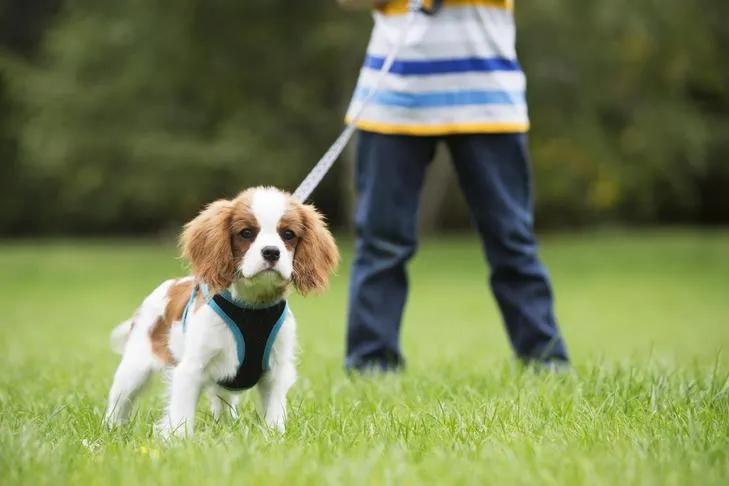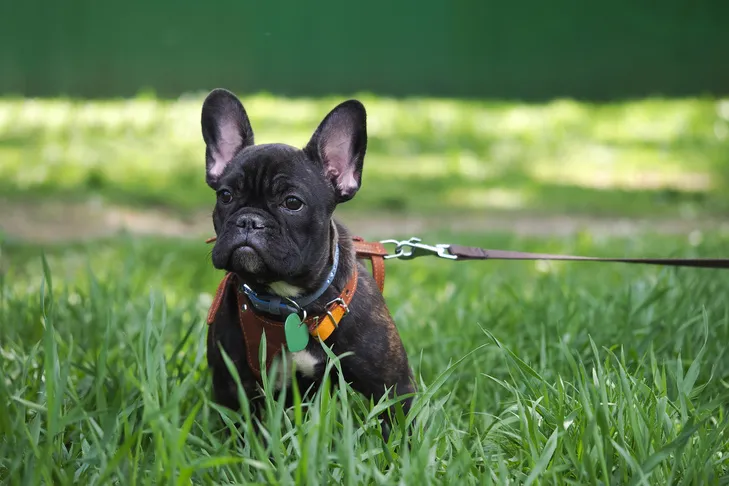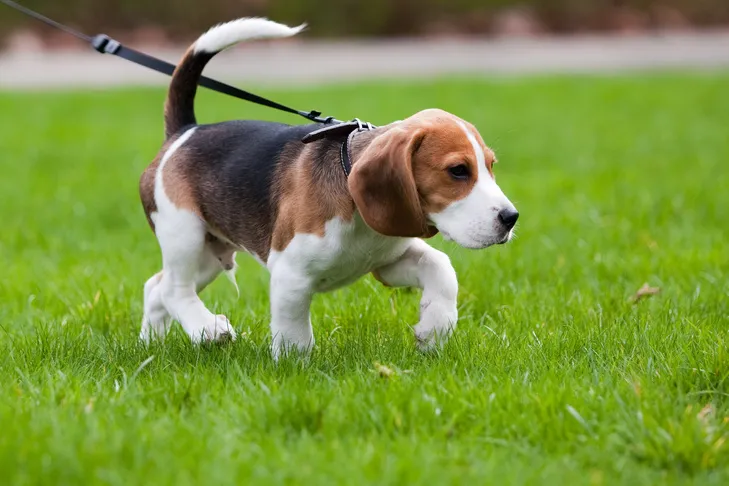Taking your puppy for regular walks is crucial for their physical health and mental well-being, providing essential exercise and vital socialization opportunities. However, puppies aren’t born with an innate understanding of how to walk politely on a leash. While some might naturally stroll alongside you and others might pull with enthusiasm, many puppies exhibit a surprising reluctance, freezing or refusing to budge as soon as the leash is clipped on. This common behavior often stems from fear, either of the collar and leash itself or of the overwhelming stimuli of the outdoors. Understanding these underlying fears is the first step in successfully teaching your puppy How To Train A Puppy To Go On Walks and transform their reluctance into excitement for outdoor adventures. If you’re also dealing with other training challenges, explore resources on how to potty train a rescue dog to ensure comprehensive training for your new companion.
Building a Positive Association with Leash and Collar
For many puppies, the leash is perceived as a form of restraint rather than a gateway to exciting experiences. This feeling can be intimidating, as being leashed means they can’t freely explore or escape perceived threats. It’s essential to help your puppy see the leash as a positive predictor of wonderful things.
Start by introducing the collar and leash in short, positive sessions within your home. Begin with the collar alone, allowing your puppy to wear it for brief periods while you offer praise, engage in playful activities, and provide delicious treats. If your puppy seems uncomfortable, gradually increase the duration. You can also play the “Gotcha” game by gently grabbing their collar before instantly rewarding them with a favorite treat. This helps them associate the collar with positive outcomes.
Once your puppy is comfortable with the collar, attach the leash, but don’t try to walk them yet. Let them drag it around the house under supervision, continuing with praise and treats. Next, use treats to lure your puppy to walk towards you while on the leash indoors. Reward every step they take in your direction. As they gain confidence, try walking together in your backyard before venturing onto the sidewalk. Remember to keep these sessions short, positive, and full of praise and rewards to build their confidence in this new skill.
 Young boy gently walking a King Charles Cavalier Spaniel in a sunlit field on a leash
Young boy gently walking a King Charles Cavalier Spaniel in a sunlit field on a leash
Socializing Your Puppy to the Great Outdoors
Moving your training outside introduces a new level of complexity, as the external environment can be incredibly overwhelming for an inexperienced puppy. The myriad of sights, sounds, and smells can trigger anxiety and make a puppy reluctant to walk. Proper and positive socialization is key to helping your puppy overcome these fears and build confidence in the world around them.
Introduce your puppy to a variety of people—different ages, sizes, and appearances, including those wearing hats, glasses, or using wheelchairs. Exposure to different dogs and varied environments, such as quiet parks, bustling sidewalks, and even pet-friendly stores, is also crucial. However, it’s vital not to force any interactions. Allow your puppy to initiate contact at their own pace. Always keep these new outdoor experiences positive by pairing them with play, praise, and high-value treats. This approach helps your puppy learn that the world outside is a safe and exciting place, seeing other people and dogs as potential friends rather than threats. For more advanced training concepts, consider exploring how to train your dog like a service dog to broaden their horizons.
 A cute French Bulldog puppy wearing a harness and leash, sitting alertly in vibrant green grass
A cute French Bulldog puppy wearing a harness and leash, sitting alertly in vibrant green grass
Making Walks Enjoyable for Your Puppy
Your puppy’s initial outdoor walks should primarily focus on enjoyment and exploration, not on mastering perfect heel commands. Encourage them to explore their surroundings, sniff interesting spots, and engage with the world at their own pace. It’s important to remember that the leash serves as a safety tool, not a control device. Avoid pulling on the leash or rushing them through bathroom breaks, as this can create negative associations. Your puppy will not learn to love walks if the leash is consistently used to pull or correct them.
Initially, it’s common for puppies to drag their heels or pull backward rather than moving forward confidently. Prioritize getting your puppy to willingly walk forward and enjoy the experience before you begin to focus on more structured loose-leash training. By consistently making walks a positive and fun activity, your puppy will quickly develop enthusiasm for going outside. Once they are happy and eager to walk, you can then introduce polite walking behaviors, making the training process smoother and more effective. If your puppy struggles with outdoor potty habits, you might find valuable tips on how to get my dog to pee in the garden.
 A curious Beagle puppy on a red leash, confidently walking through lush green grass
A curious Beagle puppy on a red leash, confidently walking through lush green grass
Advanced Tips for Reluctant Walkers
If your puppy continues to struggle with walking on a leash, consider these additional strategies:
- The “Walk Back Home” Method: Carry your puppy 20 to 30 feet away from your house and then gently set them down, allowing them to walk back home on their own. This helps them experience the sights and sounds of the outdoors while having the comfort of returning to a familiar, safe place, encouraging forward movement.
- Explore New Locations: Drive a block or two from home and then walk your puppy back, or take them to an entirely new, quiet location like a park or a pet-friendly store. Being away from the immediate vicinity of home might encourage them to explore rather than retreat, fostering curiosity.
- Motivation with Friends: Arrange for a favorite person or another well-socialized, friendly dog to stand a short distance away on the sidewalk. This provides an exciting focal point for your puppy to walk towards.
- High-Value Rewards: Reserve a special, high-value treat or toy that your puppy only receives during walks. This exclusive reward will significantly motivate them to move forward and engage with the walking experience.
- Enroll in a Positive Training Class: A well-regarded positive dog training class offers an excellent environment for socialization and provides hands-on guidance from professional trainers who can tailor techniques to your puppy’s specific needs and challenges.
Throughout all your training efforts, maintain an upbeat and positive attitude during walks. Puppies are highly sensitive to your emotions, and any frustration or worry on your part can negatively impact their perception of the experience. Keep walks short, engaging, and always conclude them on a positive note. Patience and consistency are key; it may take several weeks, but each step you take together brings you closer to your goal. With dedication, your puppy will eventually walk with enthusiasm and unwavering confidence.
